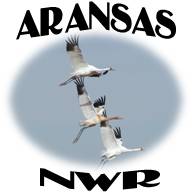October, 2010 – August, 2011
by Tom Stehn
Whooping Crane Coordinator
U. S. Fish and Wildlife Service
Highlights
The Aransas-Wood Buffalo population (AWBP) of whooping cranes rebounded from 263 in the spring of 2010 to 279 in the spring, 2011. With approximately 37 chicks fledged from a record 75 nests in August 2011, the flock size should reach record levels of around 300 this fall. Threats to the flock in Texas including land development, reduced freshwater inflows, the spread of black mangrove, the long-term decline of blue crab populations, sea level rise, land subsidence, and wind farm and power line construction in the migration corridor all continue to be important issues.
Twelve whooping crane juveniles were captured in Wood Buffalo National Park (WBNP) in August 2011, bringing the total number of radioed birds to 23. Crews visited migration stopover sites to gather habitat use data. This project is being carried out by the U.S. Geological Survey (USGS) with partners including The Crane Trust, Canadian Wildlife Service (CWS), U.S. Fish and Wildlife Service (USFWS) and others. It is funded by the Platte River Recovery Implementation Program, The Crane Trust, and the Northern Prairie Wildlife Research Center. The tracking is the first done on the AWBP in 25 years and is a top research priority of the Whooping Crane Recovery Team! Since the 1950s, 525 AWBP whooping cranes have died with only 50 carcasses recovered, and approximate cause of death was determined in only 38 instances. It is imperative that we learn more about whooping crane mortality.
Based on opportunistic sightings, the Cooperative Whooping Crane Tracking Project documented 79 confirmed sightings of whooping cranes in the U.S. Central Flyway during fall, 2010 and 49 sightings in spring, 2011.
Ten captive-raised whooping cranes were released in February, 2011 at White Lake, Louisiana where a non-migratory flock had resided up until 1950. Seven of the birds were alive after the first seven months of the project.
Production in the wild from reintroduced flocks in 2011 was again very disappointing with no chicks fledged in Florida or Wisconsin. Incubation behavior in Florida and nest abandonment in Wisconsin continued to be the focus of research. Data collected so far in Wisconsin indicates that swarms of black flies play some kind of role in a majority of nest abandonments.
The captive flocks had a good production season in 2011. Approximately 17 chicks were raised in captivity for the non-migratory flock in Louisiana, and 18 chicks are headed for Wisconsin (10 for the ultralight project at the White River marshes, and 8 for Direct Autumn Release at Horicon National Wildlife Refuge). Approximately four chicks of high genetic value were held back for the captive flocks.
Including juvenile cranes expected to be reintroduced this fall, flock sizes are estimated at 278 for the AWBP, 115 for the WI to FL flock, 20 nonmigratory birds in Florida, and 24 in Louisiana. With 162 cranes in captivity, the total of whooping cranes is 599.
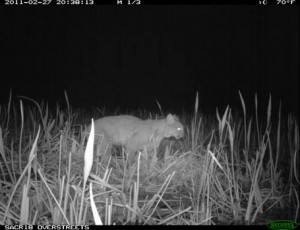 We continue to study the whooping cranes of the Florida resident flock. The flock contains 20 birds, 16 of which are paired. This spring we employed camera “traps” near nests of whooping and sandhill cranes in order to learn more about nesting issues. Camera traps, or trail-cameras as they are sometimes called, are cameras triggered by heat differential and motion. At night they use infrared “flash” to illuminate the photos. Wildlife cannot see the flash so it does not affect their behavior.
We continue to study the whooping cranes of the Florida resident flock. The flock contains 20 birds, 16 of which are paired. This spring we employed camera “traps” near nests of whooping and sandhill cranes in order to learn more about nesting issues. Camera traps, or trail-cameras as they are sometimes called, are cameras triggered by heat differential and motion. At night they use infrared “flash” to illuminate the photos. Wildlife cannot see the flash so it does not affect their behavior.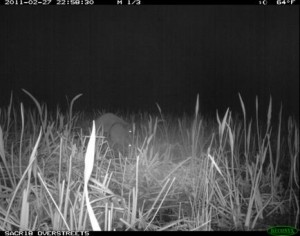
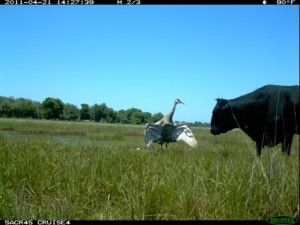
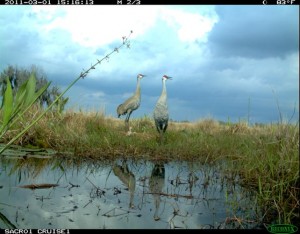
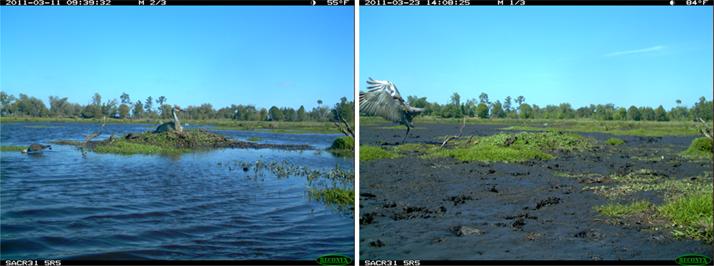
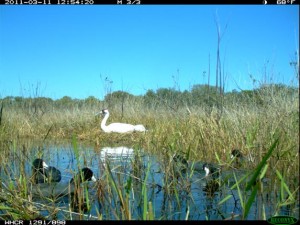
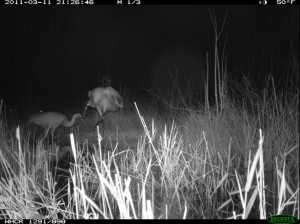
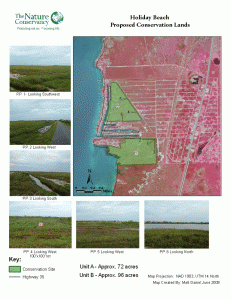
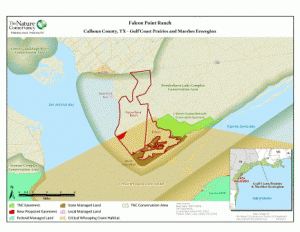
 Lucky took his first flight at 76 days of age and had become a skilled and strong flier within 2 weeks. When Lucky was older, and before he became independent of its parents, biologists captured and banded him. The attachment of a radio transmitter would allow biologists to track the chick after it left its parent’s territory. Without the transmitter the chick’s fate would never be known. At the time of capture, a small blood sample was taken. From the sample it was determined that Lucky was a male.
Lucky took his first flight at 76 days of age and had become a skilled and strong flier within 2 weeks. When Lucky was older, and before he became independent of its parents, biologists captured and banded him. The attachment of a radio transmitter would allow biologists to track the chick after it left its parent’s territory. Without the transmitter the chick’s fate would never be known. At the time of capture, a small blood sample was taken. From the sample it was determined that Lucky was a male.
